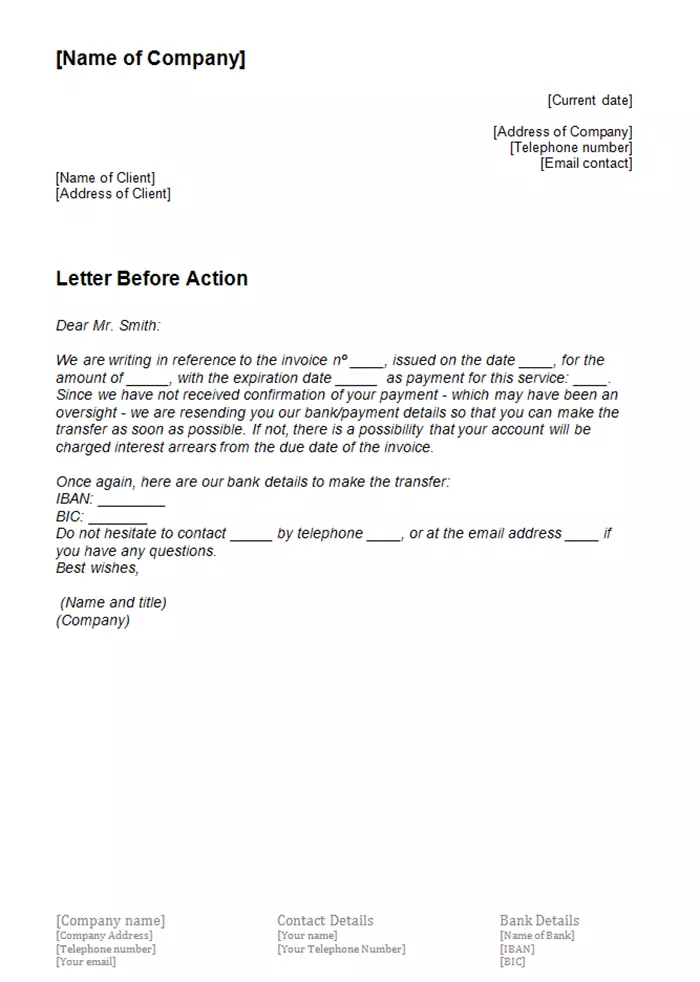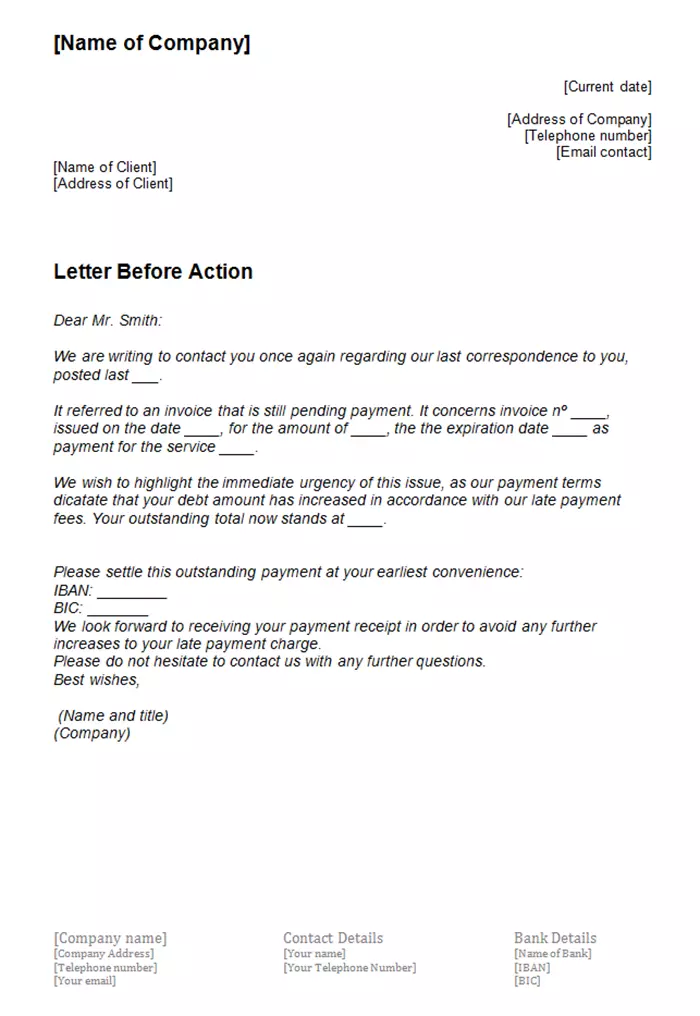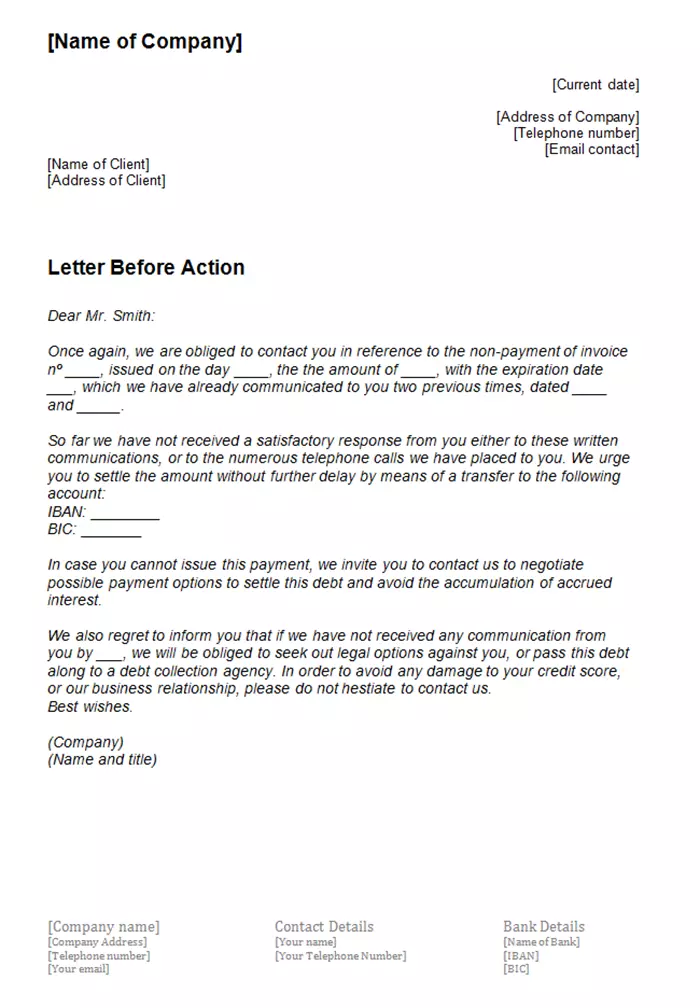Writing a letter before action: samples for professional letters requesting payment
Outstanding claims – also known as outstanding debts – threaten the solvency of a company. The more unpaid customer accounts you have, the greater the liquidity problem. High rates of outstanding debts not only lead to significant interest losses, but if payments end up having to be compensated with loans, additional costs will be incurred. Companies therefore endeavour to collect outstanding payments for services rendered in a timely manner. This is usually done through an out of court dunning process (debt collection) in which customers or business partners are informed of their default through reminders, usually in the form of letters. If out-of-court measures do not lead to the desired result, companies may have the possibility of asserting claims for payment through a court order.
In this article, we will show you how to demand a settlement for outstanding bills in a professional manner, as correct procedure is of central importance during a dunning process. As a rule, the letter before action is a prerequisite for further legal steps. In addition, judicial disputes can often be avoided by employing a commanding tone and stressing the importance of payment throughout the dunning procedure.
- Free website protection with SSL Wildcard included
- Free private registration for greater privacy
- Free 2 GB email account
Successful letters before action: best practice
The aim of the late payment reminder letter as a tool for managing receivables is to reduce the number of outstanding debts, and to avoid the loss of receivables. At the same time, a professional dunning system is also geared towards retaining customers. This should be reflected in the tonality, as well as the number of escalation levels, which we will outline here to demonstrate the business obligations to partners involved.
The legal basis for out-of-court late payment reminder letters by companies, lawyers, and credit bureaus is found in the Sale of Goods Act 1979 and the Late Payment of Commercial Debts (Interest) Act 1998 . Trading Standards oversees the implementation of these regulations. If your dunning procedure is unsuccessful, and it is necessary to bring your claim to a court, the Small Claims Court handles such matters within the UK.
Central legal concepts within the framework of the dunning system are maturity and default.
Maturity
The prerequisite for a dunning procedure is a creditor/debtor relationship, pursuant to UK laws, which allow a creditor to demand payment from his debtor for goods or services rendered. This type of debt relationship usually comes about through a contract (e.g. a purchase agreement). The following applies in principle: Missed payments can only be claimed through the dunning system if a claim exists and it can be proven that the claim is due:
If the debtor fails to provide the contractually agreed upon service until the due date (e.g. 14 days after delivery), then the creditor has the right to demand it.
Take this example:
Max Musterman wants to pave his driveway, so he buys a ton of gravel and three pallets from the hardware shop. A payment term of two weeks after the delivery date is set out in the purchase agreement. The DIY shop delivers the supplies the next day, thus fulfilling their contractual obligation, and they now have the right to reimbursement of the purchase price. This results in a debt relationship between Max Musterman as a debtor, and the hardware store as a creditor.
In the above example, the debtor automatically falls into arrears once the due date has arrived. This is a prerequisite for a creditor to assert claims against the debtor on the basis of due payment.
The term ‘maturity’ refers to the point in time when a creditor is entitled to demand an outstanding payment from his debtor. The immediacy of the debtor’s obligation to provide payment is linked to the due date.
Default
If a debtor is in default of payment, the creditor has a claim for damages (in the form of dunning charges) and interest. A prerequisite for this are circumstances which may cause delay. This is the case with non-payment, despite the due date and the reminder.
The past due reminder letter is used as a tool for debt management purposes to give debtors an extension.
In the above example, the debtor Max Musterman automatically falls into arrears because the terms of payment are specifically stated with a calendar date (14 days after delivery). It is not necessary for the hardware store to issue an additional reminder, as Max Musterman already has the time information in his purchasing agreement. However, it is common procedure toissue letter before action as soon as the due date has passed, 60 days past due date and 90 days past due date.
The legal timeframe within an invoice is required to be paid at the discretion of the contract between the debtor and the creditor. Should the debtor fail to pay by the specific date set out in the contract, the creditor may then begin the dunning procedure either themselves, or through a debt collection agency.
Letter before action: specifications
There is no legal requirement from the UK government, or specific protocol outlined in the Sale of Goods Act 1979, that defines exactly how a legal reminder, or letter before action should be formulated. In fact, the debt collector can also contact the person in written form, verbally, or through conclusive behaviour. However, Trading Standards do recommend to: “Include in the letter all the essential information: what the job was (invoice reference and date), how much is owed, for how long, and your payment information.” Whilst it is important to keep the letter as simple as possible, there are a number of aspects that it would do well to include in your letter:
- The amount of the debt, including any interest and show how you have calculated this interest.
- The name of the creditor to whom the debt is owed.
- A statement that if the consumer notifies the debt collector in writing within the thirty-day period that the debt, or any portion thereof is disputed, the debt collector will obtain verification of the debt of a copy of a judgement against the consumer and a copy of such verification or judgement will be mailed to the consumer by the debt collector.
- The date by which you would like the payment to be made, and any alternative payment options you might be willing to consider.
Due to its strong character, the letter before action is the most popular form of correspondence.
If a debtor denies having received the reminder, the burden of proof lies with the creditor. It is therefore always recommended to use the written form. In addition, it should be demonstrated that the debtor has received the warning. This can be done by commissioning a messenger to provide witness proof. In the case of a letter, the postal deliverer acts as a witness. Thus, absolute legal certainty can be provided by the enforcement agent.
The following then applies: A letter before action must be explicitly titled as such. Accordingly, even a particularly polite or humorous demand for payment fulfills the function of the reminder, provided it satisfies the above requirements. A polite professional tone is always recommended, as you do not want to tarnish your own reputation as a business through impolite or rude correspondence.
A copy of the invoice may be enclosed with a reminder. In practice, open invoices are sometimes listed directly in the letter of formal notice. This is particularly advisable if there is the possibility that the debtor has misplaced the invoice, or possibly never received it. A reminder of the payment terms and even a threat of legal consequences may be required to increase pressure on the debtors.
Letter before action: templates
In the UK, it is standard practice to send at least one letter, and up to three before taking legal action. Professional letter before action templates are a good idea to use, to ensure uniformity and professionalism in your correspondence. IONOS provides a pre-formulated sample letter for any letters before action you may require as a Word file, or in Excel format.
It is not always the case that outstanding payments are due to the unwillingness of the debtor to pay. In some cases, recipients have forgotten about the debt and settle the outstanding amounts. In other cases, the invoice may not have been received by the recipient of the invoice. In order to avoid unnecessary annoyance by defaulting clients, it is advisable to first remind them of their obligation to pay.
You may refer to the IONOS templates when creating late payment reminder letters.
Templates for your letter before action
The first reminder should be made immediately if you find that an invoice amount has not been paid despite the due date having passed. If you have no reason to doubt that the debtor will pay his debt, or if you have no knowledge of bad credit from this debtor, then the first reminder should be written in polite terms. Express in a friendly, yet unequivocal manner, that you demand the due payment.
Here is a sample of what the body of the letter could look like:
Depending on the severity of the delay and the debt incurred, stronger language may be recommended when wording your letter before action.
Second letter before action: Template for the second reminder
If the invoice is still not settled after 30 days of receiving your first reminder, it is advisable to send the debtor a second warning letter. This is usually explicitly titled with ‘reminder’ and written in a more serious, unmistakable tone. It is also advisable to provide another type of payment plan in the second warning letter:
Third letter before action: template for the last reminder
If a debtor remains inactive despite two reminders, send the third and last reminder. In this, highlight again the open invoice amount and establish a final payment date. Additionally, you should state in the third reminder that if you do not pay by the payment date, further legal actions will be taken to assert your claims. This pay include the involvement of a lawyer or the transfer of a claim to a collection office.
Avoid numbering the reminder letters, as a letter before actiontitled with ‘1st’ will give the impression that you are quite willing to disclose further reminders. This could lead defaulting debtors to await the receipt of further letters before the invoice is settled.
How to use the past due templates from IONOS
With the IONOS templates, you can create a professional letter before action. Proceed as follows:
- Download the template: All templates are available as Word or Excel files.
- File format: Select the appropriate template in the desired file format.
- Download: Click on the download link below the thumbnail for the template.
- Replace all entries with individual data: All the templates contain pre-filled text (e.g. address fields) that act as an example only. These sample statements are designed to help you understand the use of the template and ensure that your reminder contains all the important information. Go through the document field-for-field and replace the pre-filled text in the following friends with individual data.
- Header text: Each letter before action template contains a header area. This contains, in addition to the name of your company, the address of the customer to be advertised, as well as your sender’s address. Replace the placeholders with your individual details.
- Date: Make sure that your reminder is marked with the current date.
- Invoice number: Replace the sample invoice number with the number of the invoice to which your reminder refers.
- Invoice date: Replace the sample date with the date of the invoice that was not paid.
- Customer number: Enter under ‘Customer No.’ the number of the defaulting customer
- Reminder text: Depending on the template, the pre-formulated dunning texts contain data and accounting amounts. Instead, insert your individual details.
- Invoice: The third reminder contains an invoice in which the open invoice amount is added up with the default interest and the dunning costs incurred up to that point. Transfer your individual details and determine the total amount due.
- Greetings: Replace the greetings form with the preferred phrase. It is recommended to repeat the name of the signer in type-written form.
- Footnote: The footnote of a formal notice letter should include the complete address of your company, your VAT identification number, and the bank details to which the payment should be made (or details on any alternative payment methods you may wish to offer). Make sure that you completely overwrite the template’s data with your new data.
- Save and print the template: Print out and send the template to the defaulting customer. Always keep a copy of the reminder for your records. This can be done electronically by storing the Word or Excel document in a designated file folder on your system. Alternatively, print out another copy and keep the paper copy in your record books.
Unsuccessful letter before action: what now?
If the out-of-court dunning procedure does not lead to the desired result, a creditor can obtain legal assistance by taking the case to the Small Claims Court or selling the debt on to a debt collection agency
Click here for important legal disclaimers.


